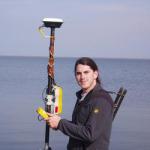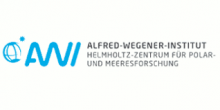The Permafrost Discovery Gateway: Navigating the new Arctic tundra through Big Data, artificial intelligence, and cyberinfrastructure
Permafrost is ground that remains frozen for at least two consecutive years. It occurs under approximately one fourth of the northern hemisphere's land surface. In the far north, the permafrost is continuous across the landscape and contains large amounts of ice in its upper few meters. Thawing of permafrost has been observed at several locations across the Arctic in recent decades, yet the pan-Arctic extent of ice-rich permafrost and permafrost degradation is not fully described. This is because it is difficult to directly measure permafrost. However, the presence and health of permafrost can be inferred from characteristic ground surface features. For example, permafrost can be detected from detailed satellite images through the presence of 30-meter-wide ice-wedge polygons. It is important to detect areas with ice-rich thawing permafrost to identify challenges for infrastructure that depend on a foundation of solid ground. This project is developing the Permafrost Discovery Gateway, an online platform that creates and makes permafrost information more accessible and discoverable by the public in a submeter resolution across the pan-Arctic scale. The public includes industry, non-profit organizations, and people living and working in the Arctic. Future workforce development includes the training of graduate students and postdocs in remote sensing technology and big data creation. Several early career researchers are the lead investigators. The K-12 education community are receiving virtual resources to help them interact with the Permafrost Discovery Gateway. In addition, a collaborative art exhibition, an interactive digital story, and an online Earth as Art gallery are displaying Arctic landscapes to the general public. These tools enable diverse peoples of different technical backgrounds to interact with permafrost knowledge across the entire Arctic. This project informs the economy, security, and resilience of the U.S., the larger region, and the globe with respect to Arctic change.
The main goal of this project is to develop supporting cyberinfrastructure to harness information from high-resolution satellite imagery. This approach is advancing the understanding of ice-rich permafrost and permafrost degradation across the entire Arctic. This project is: (1) utilizing existing Big Imagery, (2) refining and developing new automated remote sensing classification tools and big data creation workflows based on machine and deep learning techniques, (3) applying the mapping tools to pan-Arctic satellite imagery, (4) making permafrost map products and tools publicly accessible, and (5) enabling discovery through visualization and analysis tools designed with users of the Permafrost Discovery Gateway. The project is producing a cyberinfrastructure framework that also includes existing Arctic map products. This framework, along with an engaged user community, is allowing researchers to better quantify the spatial extent of ice-rich permafrost and permafrost degradation across the Arctic. Potential controls (weather, topography, vegetation, soil properties) on permafrost degradation are also being evaluated. The Permafrost Discovery Gateway helps ensure big geospatial data information access to the broader research community and encourage new partnerships around knowledge and role of Arctic permafrost.
In this four-year collaboration between Liljedahl (1927872, LEAD, UAF), Witharana (1927723, UConn), Jones (1927720, UCSB), McHenry (1927729, UIUC), and Cervenec (1927920, OSU) researchers seek to empower the broader Arctic community with a cyberinfrastructure platform, the permafrost Discovery Gateway (PDG), aimed at making Big Imagery permafrost information accessible and discoverable. This will include 1) utilizing existing public and license-restricted Big Imagery, 2) developing automated remote sensing classification tools based on machine and deep learning techniques, 3) applying tools to pan-Arctic satellite imagery to address a fundamental research question, 4) making permafrost map products and tools publicly accessible, and 5) enabling discovery and knowledge-generation through novel visualization and analysis tools designed with input from users of the PDG, e.g. the diverse peoples living, working, and/or studying in the Arctic. Regular online webinars and in-person workshops will foster continuous communication throughout the project. No fieldwork will be conducted. Two subawards are included for Alfred Wegener Institute for data processing and analysis and to Alaska Pacific University, who also represent the Local Environmental Observer (LEO) Network to gather and organize anecdotal data, facilitate connections and identify opportunities.
Co-Principal Investigators
Resources
A Permafrost Virtual Tour to Enhance the Permafrost Discovery Gateway
Virtual tours of landscapes and facilities may be created using low-cost 360-cameras, standard software packages, and basic web-hosting capabilities. Additional media may be layered onto tours to enhance the user experience. While the workflow is not arduous, time needs to be dedicated by a staff member who is comfortable with technology and willing to learn the process. Having a team willing to co-create a compelling narrative for the tour and design it with end use in mind is critical.
Publications
Dai, C., B. Higman, P. J. Lynett, M. Jacquemart, I.M. Howat, A.K. Liljedahl, A. Dufresne, J.T. Freymueller, M. Geertsema, M.W. Jones and P.J. Haeussler, 2020: Detection and Assessment of a Large and Potentially Tsunamigenic Periglacial Landslide in Barry Arm, Alaska, Geophysical Research Letters, 47(22), https://doi.org/10.1029/2020GL089800
Hasan, A., M.R. Udawalpola, C. Witharana, and A.K. Liljedahl, 2021: COUNTING ICE-WEDGE POLYGONS FROM SPACE: USE OF COMMERCIAL SATELLITE IMAGERY TO MONITOR CHANGING ARCTIC POLYGONAL TUNDRA, The International Archives of the Photogrammetry, Remote Sensing, and Spatial Information Sciences, XLIV-M-3, https://doi.org/10.5194/isprs-archives-XLIV-M-3-2021-67-2021
Hasan, A., C. Witharana, M.R. Udawalpola, and A.K. Liljedahl, 2022: DETECTION OF CLOUDS IN MEDIUM-RESOLUTION SATELLITE IMAGERY USING DEEP CONVOLUTIONAL NEURAL NETS, The International Archives of the Photogrammetry, Remote Sensing, and Spatial Information Sciences, XLVI-M-2, https://doi.org/10.5194/isprs-archives-XLVI-M-2-2022-103-2022
Jones, B.M., S.S. Tessier, T. Tessier, M. Brubaker, M. Brook, J. Schaeffer, M.K. Ward Jones, G. Grosse, I. Nitze, T. Rettelbach, S. Zavoico, J.A. Clark, and K.D. Tape, 2023: Integrating local environmental observations and remote sensing to better understand the life cycle of a thermokarst lake in Arctic Alaska, Arctic, Antarctic, and Alpine Research, 55(1), https://doi.org/10.1080/15230430.2023.2195518
Klein, K.P., H. Lantuit, B. Heim, D. Doxaran, B. Juhls, I. Nitze, D. Walch, A. Poste, and J. E. Søreide, 2021: The Arctic Nearshore Turbidity Algorithm (ANTA) - A multi sensor turbidity algorithm for Arctic nearshore environments, Science of Remote Sensing, 4, https://doi.org/10.1016/j.srs.2021.100036
Li, W., C.-Y. Hsu, S. Wang, C. Witharana, and A. Liljedahl, 2022: Real-time GeoAI for high-resolution mapping and segmentation of arctic permafrost features: the case of ice-wedge polygons, GeoAI '22: Proceedings of the 5th ACM SIGSPATIAL International Workshop on AI for Geographic Knowledge Discovery, p.62-65, https://doi.org/10.1145/3557918.3565869
Manos, E., C. Witharana, A.S. Perera, and A.K. Liljedahl, 2023: A multi-objective comparison of CNN architectures in Arctic human-built infrastructure mapping from sub-meter resolution satellite imagery, International Journal of Remote Sensing, 44(24):7670-7705, https://doi.org/10.1080/01431161.2023.2287563
Abolt, C.J., A.L. Atchley, D.R. Harp, M.T. Jorgenson, C. Witharana, W.R. Bolton, J. Schwenk, T. Rettelbach, G. Grosse, J. Boike, I. Nitze, A.K. Liljedahl, C.T. Rumpca, C.J. Wilson, and K.E. Bennett, 2024:Topography Controls Variability in Circumpolar Permafrost Thaw Pond Expansion, Journal of Geophysical Research: Earth Surface, 129(9), https://doi.org/10.1029/2024JF007675
Dai, C., I.M. Howat, J. van der Sluijs, A.K. Liljedahl, B. Higman, J.T. Freymueller, M.K. Ward Jones, S.V. Kokelj, J. Boike, B. Walker, and P. Marsh, 2024: Applications of ArcticDEM for measuring volcanic dynamics, landslides, retrogressive thaw slumps, snowdrifts, and vegetation heights, Science of Remote Sensing, 9, https://doi.org/10.1016/j.srs.2024.100130
Udawalpola, M.R., A. Hasan, A. Liljedahl, A. Soliman, J. Terstriep, and C. Witharana, 2022: An Optimal GeoAI Workflow for Pan-Arctic Permafrost Feature Detection from High-Resolution Satellite Imagery, Photogrammetric Engineering & Remote Sensing, 88(3):181-188, https://doi.org/10.14358/PERS.21-00059R2
Liljedahl, A.K., M. Kanevskiy, T. Jorgenson, B.M. Jones, R. Daanen, H.E. Epstein, C.G. Griffin, K. Kent, and M.K. Ward Jones, 2021: An Object-Based Approach for Mapping Tundra Ice-Wedge Polygon Troughs from Very High Spatial Resolution Optical Satellite Imagery, Remote Sensing, 13(4), https://doi.org/10.3390/rs13040558
Project Outcomes
The Permafrost Discovery Gateway project supported a collaborative team of researchers to enrich and communicate our understanding of Arctic permafrost thaw at small scales that matter to people living in the Arctic and across the large geographical scale of the entire Arctic that matters to our changing planet. Permafrost, defined as ground that is continuously frozen for 2 or more years, has been rapidly changing across the Arctic, but previously we have not fully quantified that change across the entire Arctic region at the small scales at which permafrost exists. Using high-resolution satellite imagery, we trained machine learning models to extract structural permafrost features across the entire Arctic from the vantage of space. Permafrost features in the landscape vary in size from the very small, such as ice wedge networks a few meters in size, to the very large, such as thaw slumps that can be kilometers in size. Researchers on the project produced the first pan-Arctic map of ice wedge permafrost features across the entire Arctic (previous maps had focused at local or regional levels), as well as other critical landscape maps such as changes in total surface water, changes in lake sizes, the presence of rapid lake-drainage events, and maps of Arctic carbon release.
NSF Award #1927720 and #1927729
These novel maps and the data backing them were published to the Arctic Data Center through the Permafrost Discovery Gateway, which we developed as an interactive and user-friendly web platform to share, view, and interact with permafrost information across the entire Arctic. This science gateway provides data and access to permafrost information across the Arctic to both research and public users, while also connecting different user groups around questions and problems that can be addressed with the data and tools available in the gateway. For example, permafrost thaw has been observed at many locations across the Arctic in recent decades, yet the pan-Arctic extent and local variations in thaw were poorly described. By quantifying and visualizing permafrost changes with satellite imagery, both local communities and we as a broader society improve our knowledge of changes in the Arctic and can use that information to improve people’s lives. Now, local communities can use permafrost maps from the gateway to better understand where permafrost is melting in their communities, and plan to mitigate some of the worst effects of these changes, such as building and road damage, coastal erosion, and changes in surface water flows across the region.
By developing the computing and modeling infrastructure in this project, and by producing new scientific data products on the distribution and impacts of permafrost landscape features, we created new capabilities to map, understand, and mitigate Arctic-wide changes in permafrost that will have major impacts on society.
NSF Award #1927920
This project created a permafrost layer within Fluid Earth, accessible at https://go.osu.edu/permafrost and linked to the Permafrost Discovery Gateway at https://arcticdata.io/catalog/portals/permafrost/. The code for Fluid Earth was updated to modern standards and made more accessible via changes to color palettes. An education support video was created by an undergraduate REU student to improve access.
To enhance education about permafrost, a Virtual Tour of the CRREL Permafrost Tunnel was created for asynchronous access on computers, tablets, and VR headsets. This tour is available to anyone with an internet connection and was featured at the Arctic Data Center booth at the 2023 and 2024 AGU Fall Meetings. In spring 2023, the project team streamed a synchronous tunnel tour and question and answer session with experts for an audience of more than 500 individuals. More than 100 questions were answered as part of the program with a recording accessible following the event. The virtual tour, recorded live program, and list of questions with responses is available at https://byrd.osu.edu/permafrost-tunnel-gateway-tour.
The project team also participated in brainstorming sessions to develop educational experiences for youth.
The code repository associated with this project is available at https://github.com/byrd-polar/fluid-earth.
Publications associated with this project include:
- Cervenec J, Davis G, Gravina MT, Hamilton D. A Tool for Exploring Our Fluid Earth. The physics teacher. 2023 September; 61(6):432. DOI: Phys. Teach. 61, 432–435 (2023) https://doi.org/10.1119/5.0132110
- Gravina, M., Zhan, M., Cai, M., Arens, A., and Cervenec, J. (2022, Apr 29). Fluid Earth: Open-source Visualization of Weather and Climate Data. GIS Lounge. https://www.gislounge.com/fluid-earth-open-source-visualization-weather-climate-data/












